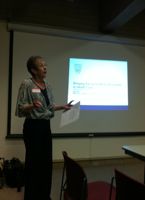Newsletter–June 2013
AMWA 2013 Spring Event Wrap Up: Bringing the Social Media Revolution to Health Care
by Deborah Tolmach Sugerman


Fifteen North Central chapter members gathered in Richfield on Tuesday evening, May 7, for an informative and entertaining presentation by social media guru Lee Aase. Aase, 50 (yes, his age is relevant), heads up Mayo Clinic’s Center for Social Media and he had plenty of insights to share. Originally a political science major with a minor in chemistry, Aase came to Mayo in 2000. He became public affairs manager in 2003 and director of the Center for Social Media in 2010.
As a grandfather, albeit a young one, he’s qualified to assert that none of us is too old to learn about social media. He says all it takes is an “I’ll bet I could do that” attitude, for which he credits his parents.
What’s more, one could say Aase owes his grandchildren’s existence to Facebook. His daughter met her future husband on Facebook when she was in college. And—listen up all you Luddites—he and his wife frequently connect with their grandchildren via Skype and FaceTime, erasing the 9-hour driving distance between them.
Aase began his talk by asking the group about their current social media use. Answers ranged from “I’m kind of a Luddite” and “I don’t want to look at my computer after I leave work” to “I manage a Facebook discussion group” and “I got job offers from my LinkedIn account.”
Aase then went on to discuss the history of social media at Mayo Clinic, essentially the story of his Mayo career, beginning with the Mayo Medical Edge—information delivered via newspaper, radio, and TV. He started blogging for Mayo in mid-2006, far ahead of the curve. He later added a Facebook and Twitter presence to Mayo’s communication tools.
Aase told the AMWA group about his introduction of the flip video camera to the patient visit, including “meeting” the doctor through a video, and having the doctor record standard follow-up care. He then introduced the group to some basic social media tools:
- Blogs: easy-to-publish websites that allow comments – such as WordPress and Blogger (from Google).
- RSS: stands for really simple syndication. An e-newsletter that can’t spam you and lets you follow news sites without surfing.
- Podcasts: digital audio or video files; like TiVo for audio and video
- Facebook and LinkedIn: no explanation needed! Did you know AMWA has LinkedIn groups, both national and for the North Central Chapter?
- Wikis: collaborative editing tools. Wikipedia is best known, having put encyclopedias out of business.
- YouTube: world’s second-largest search engine after Google. Lots of how-to videos.
- Twitter: a group blog with extremely short stories
- Yammer: private network an organization can establish via employee e-mail
- Slideshare.net: YouTube for PowerPoint
- uSteam.tv: your own global TV channel
- Pinterest.com: a shared cork board
Recommended books and video:
- Mayo’s Bringing the Social Media Revolution to Health Care
- To Sell Is Human by Daniel Pink
- “Blogs in Plain English” YouTube video by Lee LeFever
In conclusion, Aase took a step back and put social media into the bigger picture of human communication, including the spoken word and the invention of the printing press. Putting social media into that larger context helped make the tools seem less frightening and more accessible.
Aase has many theses (35 to be exact) that guide his social media activities, but number 7 pretty much sums up his overall philosophy: “Hand-wringing the merits and dangers of social media is as productive as debating gravity.”
And with thesis number 35, Aase foresees the impact of social media on health care itself: “Social technologies will transform health care.” Social media is far more than a game-changing public relations tool, said Aase. The role of social media in patient education and managing the delivery of health care is just beginning. Aase sees himself as a facilitator and resource for this next chapter. To learn more, visit his SMUG site, described as a “post-secondary educational institution dedicated to providing practical, hands-on training in social media to lifelong learners.”
Following the presentation, a smaller group of attendees gathered at nearby Pizza Luce for food, drinks, and conversation. Thanks to the Program Committee for organizing a great evening. Hope to see you all at the next event.
The Benefits of LinkedIn – Build Your Professional Profile and Expand Your Network
by Sharon Rosen
Need to get the word out about the services you and your company offer? Want to expand your professional network? Looking for information about your industry? Searching for a job? LinkedIn, the online professional network, can help.
Founded in 2003 and based in Mountain View, CA, LinkedIn’s mission is to connect professionals to make them more productive and successful. As a member of LinkedIn, you have access to people, jobs, news, updates, and insights that help you in your job and career.
Additional key facts:
- LinkedIn has more than 225 million members from 200 countries around the world.
- LinkedIn members include executives from all Fortune 500 companies.
- LinkedIn members represent a broad range of industries, including technology, financial services, media, consumer packaged goods, entertainment, and health care.
How to create an effective profile on LinkedIn
If you are not currently a member of LinkedIn, it is easy to create a profile for yourself, free of charge. Your profile will include your name, company name and location, job title, description of your current position, list of past positions held, and educational background. LinkedIn offers you the opportunity to customize your profile and control the information that others see and read about you. This gives you the opportunity to showcase your skills and talents.
Tips for developing an effective profile:
- Use the summary section of the profile to highlight your professional background and interests.
- Use the specialties field to list your areas of expertise to help potential employers or collaborators find you when they are seeking talent.
- Use the experience section to list your employment history in chronological order. For each position listed, include company name, job title, and a bulleted list of responsibilities. Highlight positive changes or improvements that you made while at each position.
- Use the education section to highlight honors received or associated activities that helped develop your job skills.
- Use the additional information section to give users more insight into your professional capabilities. List any memberships and accomplishments in professional organizations to which you belong.
Join a LinkedIn group to build your professional network and share valuable resources
There are more than 1 million LinkedIn groups covering a broad range of topics available to LinkedIn members. Members can choose their level of participation within a group and can control the flow of information they receive from a group by selecting whether they want to receive daily or weekly e-mail updates.
Benefits of being a member of a LinkedIn group:
- Learning about the latest developments in a particular industry or topic area
- Sharing resources and information with other professionals
- Researching companies and professional associations within your industry
- Making contacts with others in your industry
- Learning about job opportunities within your field of expertise
Create your own LinkedIn group and share your knowledge while building your business
By creating a LinkedIn group, you can bring together other professionals around a specific topic or mission. When you create a group, your name is featured as the owner. You can also provide background information about your professional credentials and links to your company’s website. As the group owner, you establish yourself as a thought leader on a particular topic. By creating a group, you attract other professionals with similar interests and expand your own network.
Additional benefits of creating a LinkedIn group:
- Driving traffic to your company website or attract professionals who are seeking your services
- Sharing information and resources
- Starting the conversation about important topics
- Helping others reach their professional goals
Stay tuned for a follow-up article that discusses LinkedIn in greater detail.
